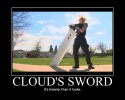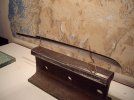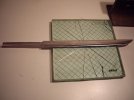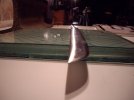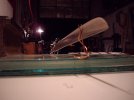- Joined
- Dec 27, 2010
- Messages
- 6,852
Since it appears you're still interested, I'll respond with a bit more detail. Your comment is a bit too simplistic, and some of it isn't really exactly correct when it comes to swords (mainly thinking of of the aesthetic part, because while that may be a side benefit, in a sword, a fuller is definitely going to have more than just decorative effect).
There's definitely plenty of good reasons to use fullers. And it's definitely beyond question that a fullered blade is stronger than an unfullered one of equal mass, forged, ground, or whatever. But if you don't mind the extra mass, you don't really lose anything from not fullering, since more material resists deformation better than less material, no matter where you remove it. Think of it this way. Arches are insanely strong. They can support far more weight than you might think, because they're so structurally sound. Fullers work on a similar principle, by distributing the stresses from a particular direction in such a way that more of the material is involved in resisting the force. HOWEVER, it would be a mistake to assume that the arch is stronger than a solid wall to stresses exerted in the same direction.
More, the fullers don't do much to resist forces exerted from other axes, and are particularly weak to torque. The idea is that they shouldn't really get torqued. That tends to be somewhat risky with swords, which definitely CAN and DO get torqued along the length of the blade during combat, but generally it was considered more important to improve the weight distribution. The best blades would be designed for the impacts to be taken along a harmonic curve relative to the design and material, again to improve the durability and power of the blade. Thus, some blades would be fullered and others wouldn't. The cinqueada is a good example of how fullers could be used both to reduce weight and for aesthetics.

(This one was made by Hanford Miller).
As you can imagine, such a wide blade would be very difficult to balance. The fullers help with that task by reducing weight along the blade, but, due to the complexity of the fuller style, it's also got a very distinctive aesthetic. Fullers can be purely decorative, but only on small blades, in which the weight change is negligible. On a sword, it's definitely going to have an effect. Even a thin fuller can change the balance point by anywhere from half an inch to several inches, and that's without really sacrificing structural integrity. Note, you're not going to GAIN any structural integrity. But you can reduce weight without losing much, if any, depending on the placement and dimensions of the fuller. You may see a notable difference in context of STIFFNESS, however, which may or may not be a good thing, depending on the type of sword and its intended uses.
For instance, it's pretty rare to see a fullered rapier or tai chi sword, because those are supposed to bend and be whippy. Making them stiffer, given the low amount of material being used, would just make them more prone to break.
And I just have to point out how untrue it is that fullering has to be done via forging. In fact, the Japanese process of fullering (fullers are called hi, or bohi, if I recall), uses a long, cylindrical draw-knife to cut the material out, and then steel needles to polish. Others use a small wheel on a grinder, but most makers these days use a mill. Even IF you forge it in, you're still essentially removing material. Forging a fuller would widen the blade, requiring less material to forge than an unfullered blade. The process is irrelevant. At the end of the day, you're still decreasing material.
So, you get two effects from a fuller. Aesthetics may play an incidental role in a sword, but you're going to get lighter weight, stiffness (how much can really vary), and you don't significantly decrease strength relative to impacts on the edge. Whether these are necessary for the particular application really depends on what the smith is trying to accomplish.
In this circumstance, working with something that's already quite light, you're going to want to find a balance. Weight, as horseclover has pointed out, can actually be really important to a sword. Except under very specific circumstances (mainly thinking about weapons designed for either piercing (and hence speed), or else intended to be used against unarmored opponents), reducing weight isn't actually necessarily desired, particularly if you don't get the balance right, or the placement of the point of percussion in the correct spot along the harmonic curve. A really light blade would be entirely unable to penetrate even light armor, for instance, where a heavier blade would have the power to defeat the same armor. A cheap plastic soccer shin-guard provides a good example. A heavy steel blade can actually cut through. I'd be interested to see if one of these Ti blades would be capable of the feat. Will fullering provide an advantage? I'm not really seeing one, except for applications like the fantasy weapons I mentioned earlier, in which you'd still want to reduce weight. And it would be pretty darn cool to see a functional buster sword that could actually be wielded reasonably, although I'm not sure even Ti could accomplish that goal. Something to consider, perhaps, Mecha?
There's definitely plenty of good reasons to use fullers. And it's definitely beyond question that a fullered blade is stronger than an unfullered one of equal mass, forged, ground, or whatever. But if you don't mind the extra mass, you don't really lose anything from not fullering, since more material resists deformation better than less material, no matter where you remove it. Think of it this way. Arches are insanely strong. They can support far more weight than you might think, because they're so structurally sound. Fullers work on a similar principle, by distributing the stresses from a particular direction in such a way that more of the material is involved in resisting the force. HOWEVER, it would be a mistake to assume that the arch is stronger than a solid wall to stresses exerted in the same direction.
More, the fullers don't do much to resist forces exerted from other axes, and are particularly weak to torque. The idea is that they shouldn't really get torqued. That tends to be somewhat risky with swords, which definitely CAN and DO get torqued along the length of the blade during combat, but generally it was considered more important to improve the weight distribution. The best blades would be designed for the impacts to be taken along a harmonic curve relative to the design and material, again to improve the durability and power of the blade. Thus, some blades would be fullered and others wouldn't. The cinqueada is a good example of how fullers could be used both to reduce weight and for aesthetics.

(This one was made by Hanford Miller).
As you can imagine, such a wide blade would be very difficult to balance. The fullers help with that task by reducing weight along the blade, but, due to the complexity of the fuller style, it's also got a very distinctive aesthetic. Fullers can be purely decorative, but only on small blades, in which the weight change is negligible. On a sword, it's definitely going to have an effect. Even a thin fuller can change the balance point by anywhere from half an inch to several inches, and that's without really sacrificing structural integrity. Note, you're not going to GAIN any structural integrity. But you can reduce weight without losing much, if any, depending on the placement and dimensions of the fuller. You may see a notable difference in context of STIFFNESS, however, which may or may not be a good thing, depending on the type of sword and its intended uses.
For instance, it's pretty rare to see a fullered rapier or tai chi sword, because those are supposed to bend and be whippy. Making them stiffer, given the low amount of material being used, would just make them more prone to break.
And I just have to point out how untrue it is that fullering has to be done via forging. In fact, the Japanese process of fullering (fullers are called hi, or bohi, if I recall), uses a long, cylindrical draw-knife to cut the material out, and then steel needles to polish. Others use a small wheel on a grinder, but most makers these days use a mill. Even IF you forge it in, you're still essentially removing material. Forging a fuller would widen the blade, requiring less material to forge than an unfullered blade. The process is irrelevant. At the end of the day, you're still decreasing material.
So, you get two effects from a fuller. Aesthetics may play an incidental role in a sword, but you're going to get lighter weight, stiffness (how much can really vary), and you don't significantly decrease strength relative to impacts on the edge. Whether these are necessary for the particular application really depends on what the smith is trying to accomplish.
In this circumstance, working with something that's already quite light, you're going to want to find a balance. Weight, as horseclover has pointed out, can actually be really important to a sword. Except under very specific circumstances (mainly thinking about weapons designed for either piercing (and hence speed), or else intended to be used against unarmored opponents), reducing weight isn't actually necessarily desired, particularly if you don't get the balance right, or the placement of the point of percussion in the correct spot along the harmonic curve. A really light blade would be entirely unable to penetrate even light armor, for instance, where a heavier blade would have the power to defeat the same armor. A cheap plastic soccer shin-guard provides a good example. A heavy steel blade can actually cut through. I'd be interested to see if one of these Ti blades would be capable of the feat. Will fullering provide an advantage? I'm not really seeing one, except for applications like the fantasy weapons I mentioned earlier, in which you'd still want to reduce weight. And it would be pretty darn cool to see a functional buster sword that could actually be wielded reasonably, although I'm not sure even Ti could accomplish that goal. Something to consider, perhaps, Mecha?

